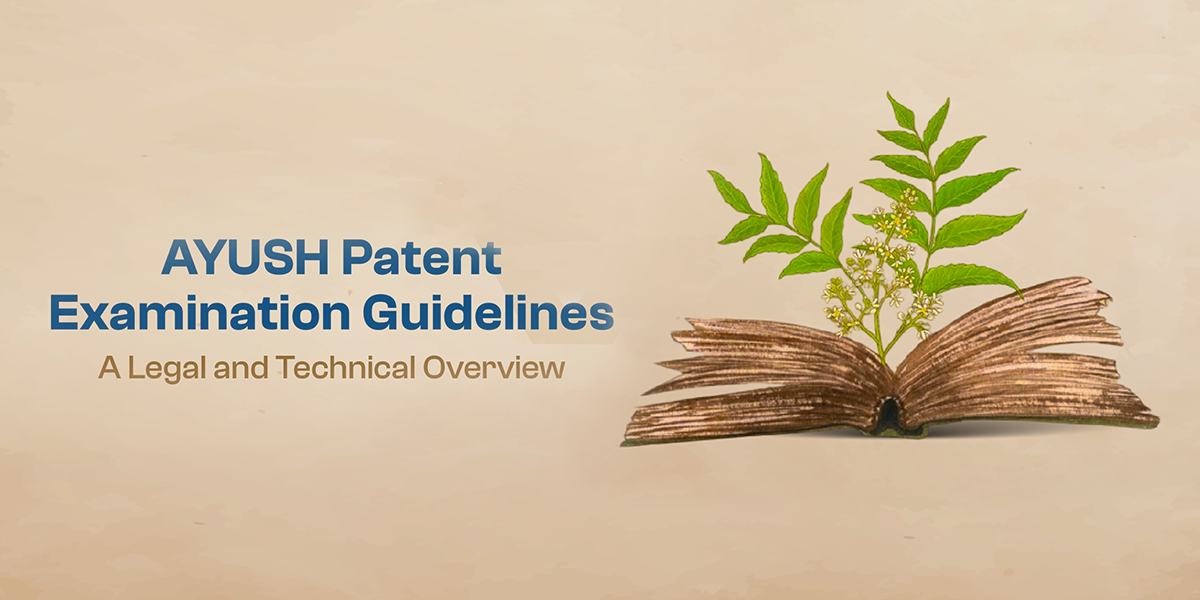
AYUSH stands for Ayurveda, Yoga, Naturopathy, Unani, Siddha, and Homeopathy. It refers to traditional Indian medical systems supported by the Indian government’s Ministry of AYUSH. These systems, including Ayurveda and Yoga, have long been valued for their cultural importance and healing properties. With increasing innovation in these domains, the Indian Patent Office has issued dedicated Guidelines for Examination of AYUSH-Related Inventions, 2025, to safeguard patent rights for truly novel and inventive AYUSH innovations. These guidelines provide clarity on how AYUSH-based inventions are assessed under the Patents Act, 1970, and aim to strike a balance between protecting traditional knowledge and encouraging meaningful innovation.
One of the core principles of the guidelines is that mere traditional knowledge is excluded from patentability under Indian law. If an invention merely reproduces or repackages known AYUSH practices, classical formulations, or therapeutic methods without any technical advancement, it will not meet the criteria for novelty or inventive step. The guidelines emphasise that applicants must go beyond what is already known and demonstrate a distinct contribution to the field.
The Traditional Knowledge Digital Library (TKDL) plays a central role in the examination process. It is treated as a valid source of prior art, and any invention that is already disclosed in TKDL is considered anticipated. Examiners are instructed to consult TKDL during prior art searches, making it essential for applicants to verify that their claimed invention is not already documented in this repository.
Inventions that claim therapeutic efficacy must be supported by experimental data. The guidelines make it clear that mere assertions or anecdotal references are insufficient. Applicants are required to submit reproducible experimental results, validated clinical trials, , or laboratory data to substantiate claims related to treatment, healing, or physiological effects. This requirement ensures that patents are granted only to inventions with demonstrable utility.
If an invention involves the use of biological material, such as herbs, plant extracts, or microbial strains, the source of the material must be disclosed in the patent application. Additionally, compliance with the Biological Diversity Act, 2002 is mandatory. This includes obtaining prior approval from the National Biodiversity Authority (NBA) where applicable. Failure to comply with these requirements may result in objections or refusal of the application.
The guidelines stress the importance of clarity and specificity in claim language. Terms such as “synergistic effect,” “effective amount,” or “safe dose” must be supported by data and clearly defined in the specification. Vague or ambiguous claims are likely to be rejected during examination. Applicants must ensure that the claims are fully supported by the description and are technically sound.
AYUSH-related inventions must be carefully evaluated against statutory exclusions under Section 3 of the Patents Act. Section 3(i) excludes methods of treatment for humans or animals from patentability. Therefore, claims must be drafted in a manner that avoids falling under this category. Similarly, Section 3(b) prohibits patents for inventions that are contrary to public order or morality. Examiners are instructed to assess whether the claimed subject matter complies with these provisions.
Reformulating known AYUSH remedies into novel dosage forms, such as transdermal patches, nano-emulsions, or sustained-release tablets, must demonstrate unexpected technical benefits to be considered inventive. The guidelines require that such modifications demonstrate a technical advancement or unexpected benefit. Applicants must establish that the new form offers improved efficacy, stability, or delivery characteristics compared to existing formulations.
Inventions related to yoga-based devices or systems must show a tangible technical contribution. Claims based solely on spiritual or therapeutic benefits are not patentable. The guidelines require that such inventions involve a demonstrable improvement in design, functionality, or user experience that goes beyond traditional practice.
Homeopathy-based inventions must be clearly differentiated from known remedies and practices. The guidelines require that applicants establish novelty and inventive step through formulation changes, delivery mechanisms, or therapeutic enhancements. Superficial modifications or commercial rebranding of existing homeopathic remedies do not meet patentability criteria.
If the invention refers to classical texts or traditional sources, the references must be complete, traceable, and relevant to the claimed subject matter. Applicants must ensure that citations are accurate and that the invention is clearly distinguished from the referenced material. This helps examiners assess the novelty and inventive step of the claimed invention.
Patentable inventions must demonstrate industrial applicability, reproducibility, and scalability, as required under Section 2(1)(j) of the Patents Act. This includes demonstrating practical utility, reproducibility, and scalability. Applicants must ensure that their claims and specifications meet all formal and substantive requirements.
The AYUSH patent examination guidelines provide a structured framework for evaluating innovations in India’s traditional medicine sector. To improve the likelihood of successful patent outcomes, it is advisable that innovators consider these guidelines early in the R&D process and ensure that AYUSH-specific requirements—such as novelty, inventive step, and compliance with TKDL and biodiversity laws—are thoroughly addressed. Legal expertise and strategic drafting aligned with these guidelines are essential to secure robust and enforceable patent protection.
Yashvi is a dedicated member and a skilled Patent Agent with a strong background in Electrical Engineering. She specializes in patent prosecution and opposition matters, bringing extensive experience and strategic guidance to complex IP disputes. Her expertise ensures robust protection of clients’ innovations. Yashvi holds a degree in Electrical Engineering from Techno India NJR Institute of Technology, Udaipur—her engineering roots fuel her insight across diverse technical domains.